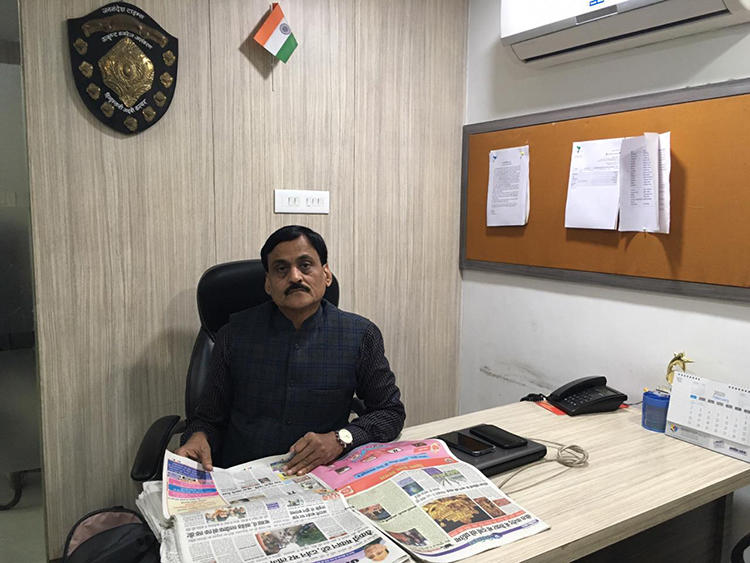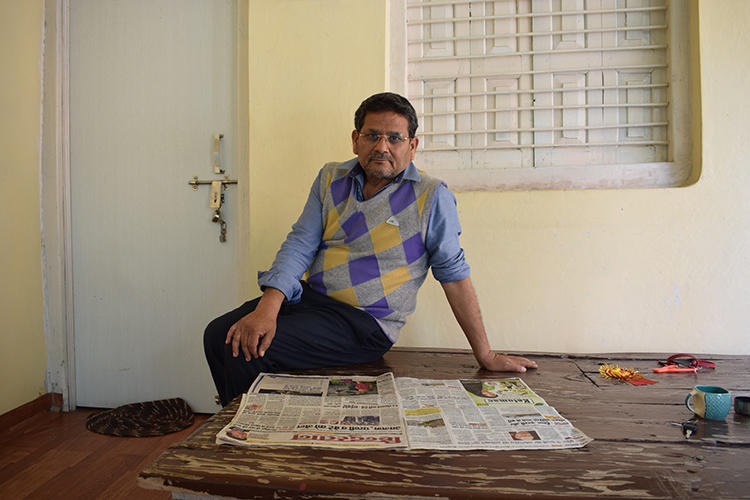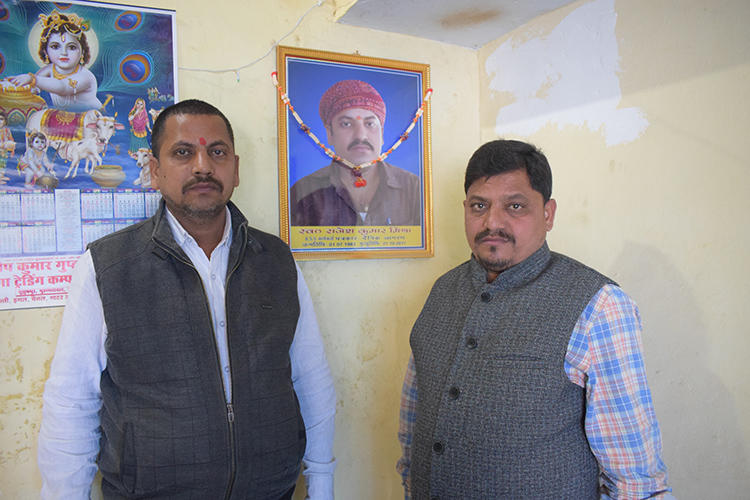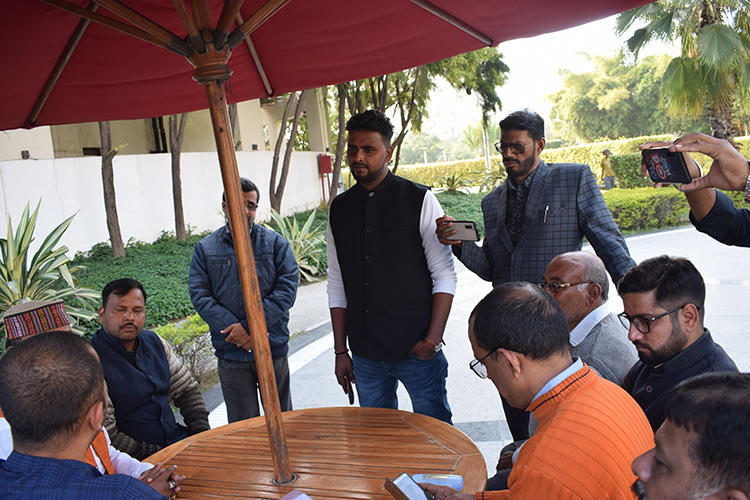Also available in हिंदी में
On March 26, two days after Indian Prime Minister Narendra Modi announced a national lockdown to control the spreading of COVID-19, Hindi-language daily Jansandesh Times reported that a tribe in Varanasi, Uttar Pradesh state, didn’t have enough to eat due to the sudden announcement and that children were eating grass. The same day, the magistrate of Varanasi district, Kaushal Raj Sharma, sent a legal notice to the newspaper claiming that part of its report was false and “sensationalized,” according to a copy of the notice reviewed by CPJ. He demanded the newspaper issue an apology within 24 hours or he would take legal action against the authors, Vijay Vineet and Manish Mishra.
It’s not just Jansandesh Times that is in the crosshairs of authorities in Uttar Pradesh. While press freedom violations have long taken place in the state, journalists told CPJ that since the Bharatiya Janata Party maintained its parliamentary majority in Uttar Pradesh during India’s May, 2019, general election, there has been a surge in the number of such incidents in India’s most populous state. During a trip to Uttar Pradesh in late February and early March, journalists told CPJ that they felt under increased threat of criminal charges and physical assault. Such fear could lead to self-censorship.
The trend is particularly alarming as the COVID-19 pandemic makes the flow of news and information critical to citizens’ health and economic survival. And while journalists say some violations have come at the hands of police and other authorities, others have come from organized crime – including river-sand mafia and a group that runs hospitals.
“A national lockdown is precisely the time when journalists in a democracy need to be free to write and report without worrying about a midnight knock,” Siddharth Vardarajan, the editor of Indian news website The Wire, wrote April 21 in The New York Times. Vardarajan has been the subject of several defamation suits and criminal complaints for his work – most recently for criticizing Uttar Pradesh Chief Minister Yogi Adityanath’s conduct during the national lockdown, as CPJ has documented.
The BJP’s overwhelming win in the state in the May election has emboldened Adityanath’s government, said Amitabh Bhattarcharya, freelance journalist and former bureau chief of English daily Northern India Patrika.
“It feels it can do anything with impunity, just because it has won two elections in a row,” he said.
Since taking control of the state in 2017, Adityanath has tried to build an image as a tough task master with no tolerance for public disturbances. The chief minister is a Hindu monk and right-wing politician who openly calls for India to become a Hindu nation. While he claims he has vastly improved law and order in the state, his government has also been accused of supporting extrajudicial killings, clampdown on non-violent protesters and arrests of political opponents and civil rights activists, as widely reported in national and international media.
Awanish Kumar Awasthi, Uttar Pradesh home and information secretary, did not respond to a request for a meeting during CPJ’s visit to the state.
Jansandesh Times has stood by its reporting on the consequences of the lockdown in Varanasi. Vineet, who is the editorial head of the newspaper in eastern Uttar Pradesh, says this is not the first time he’s clashed with the local administration in the state over his newspaper’s reporting.
In Azamgarh, about 170 miles east of the state capital Lucknow, Jansandesh Times reporter Santosh Jaiswal was arrested on September 7 last year after reporting that students in a school were being forced to clean the premises. In Mirzapur, about 180 miles southeast of Lucknow, Pawan Jaiswal (no relation to Santosh) was charged with criminal conspiracy on August 31 last year after he reported that a local school was serving meals below the government’s minimum standards. The state government stopped advertisements to the newspaper for three months, Vineet said. In both these cases, after public outrage and months of campaigning, the government withdrew the cases, he said.

But this time, Vineet told CPJ over the phone that he anticipates he will be arrested because he fears the state government may misuse its expanded power under the colonial-era Epidemic Diseases Act, which the federal government implemented on March 11 and which gives state governments the power to penalize media organizations for spreading misinformation. Speaking to television journalists on March 26, Sharma, the district magistrate, threatened to do exactly that. Should he move forward, Vineet and Mishra could each face up to six months in jail and a fine of 1000 rupees (about US$15) or both.
Legal and physical harassment
Over the past year, CPJ has documented several attacks on journalists related to critical reporting of governance at various levels of the state. These included the arrest on June 8 of TV news channel reporters from Nation Live, as well as a freelancer, for allegedly attempting to incite violence and defaming the chief minister. The journalists are now out on bail, but the news channel was shut down for allegedly operating without proper government clearance.
“Noida district police have created a template for the rest of the state by claiming that Nation Live journalists were creating a possible law and order disturbance by defaming the CM [chief minister],” said Abhishekh Srivastava, senior journalist and convener of Committee Against Assault on Journalists (CAAJ).
On June 11, railway police detained a journalist with privately owned Hindi news broadcaster News 24 for two hours in Shamli district, hit and kicked him, stripped him, and urinated in his mouth, as CPJ documented at the time. The state government responded quickly, and the policemen were suspended and criminal cases were filed against four. But government officials and police continued to target journalists with detention or criminal charges.
“I don’t know if the CM [chief minister] suggested the bureaucrats and police to go after journalists but at that point it felt as if targeting journalists had become a state policy,” said Utpal Pathak, a local freelance journalist.
In Varanasi, the city on the banks of the Ganges river in eastern UP, Baccha Gupta, a photojournalist with Swatantra Chetna newspaper, told CPJ that police filed a case of charged him with trespassing and criminal conspiracy in November after he took photographs of children cleaning a flooded police station near river Ganges.
“Journalists at the state or the national level can be ‘managed’ via their management or through some kind of incentive by the ruling dispensation [such as government advertising] but that’s difficult at the district or the village level,” said Lenin Raghuvanshi, founder of the local human rights group People’s Vigilance Committee on Human Rights. “That’s why the only way to stop them from doing their job honestly is by targeting them with legal cases.”
REFUSAL TO INTERVENE
In some cases, journalists told CPJ that local authorities and police have been complacent when journalists have been targeted by non-state actors or politicians.
Most worryingly, given the public health crisis, Akash Yadav, a journalist with Dainik Bhaskar, accused the police in Varanasi of being aligned with a local hospital mafia, which accused him and five other journalists of robbery and sexual harassment after he reported in October that a private hospital was being run by an unqualified doctor, Yadav told CPJ. His local editor Ghanshyam Pathak said there is a nexus between the police and the private hospitals.
“We are really disturbed because we constantly get threats from various officials who keep suggesting that we shouldn’t report on such issues. They say we should work in tandem with the administration and the police,” Pathak said.
Vineet, who supervises nearly 400 part-time and fulltime reporters in 13 eastern districts of the state, said attacks on local journalists by members of mafia are a major safety concern.
“Unlike at the state level, district and village level journalists don’t have any support system,” he said. “They are at the mercy of the local administration.”
In one case, a mob attacked Krishna Kumar Singh, a journalist with Hindustan newspaper in Mirzapur, in September. He told CPJ that he has been the subject of legal accusations of physical assault and abuse since he started reporting on a local parking mafia, which he alleged is supported by local politicians. “The police took over six hours to register a case of assault even though many police officials were present when I was mercilessly beaten up,” he said.

And Manoj Kumar Soni, a journalist with Hindi daily Dainik Perfect Mission in Sonbhadra district, told me he was attacked by six men with iron rods on November 4, resulting in broken knees and other injuries. Soni told CPJ that this was the second time he was attacked by the local land mafia, and that he had filed a police complaint when he was first attacked in 2018, but police took no action. For the second attack, he was hospitalized for more than a month and has spent nearly US$3500 in medical fees.
A police spokesperson at Sonbhadra told CPJ that they are still investigating the incident.
Underlining the sense of impunity in attacks on journalists, the murder of reporter Rajesh Mishra, who was gunned down in 2017 in Ghazipur, a few months after Adityanath came to power, remains unresolved. I traveled to Ghazipur, where his family said the trial in his case has not begun.
“Yogi ji [Adityanath] had promised a quick investigation but the police says one of the killers is still at large,” his brother Brijesh Kumar Mishra told me, adding that the local river sand mafia is suspected to be behind his brother’s murder. A local police officer, Ravinder Pandey, told me over phone that nine of the 10 accused are in police custody and the police will be seeking a date for trial soon.

While journalists wait for law enforcement to solve such crimes, Yogesh Mishra, senior journalist and editor of Newstrack, a Hindi-language news website, said police in Uttar Pradesh are going after journalists for even the smallest matter. “Once upon a time politicians used to bring tea and ask you for your source. Now they outrightly abuse you,” he said. “It doesn’t seem like we live in a democracy,” he added.
